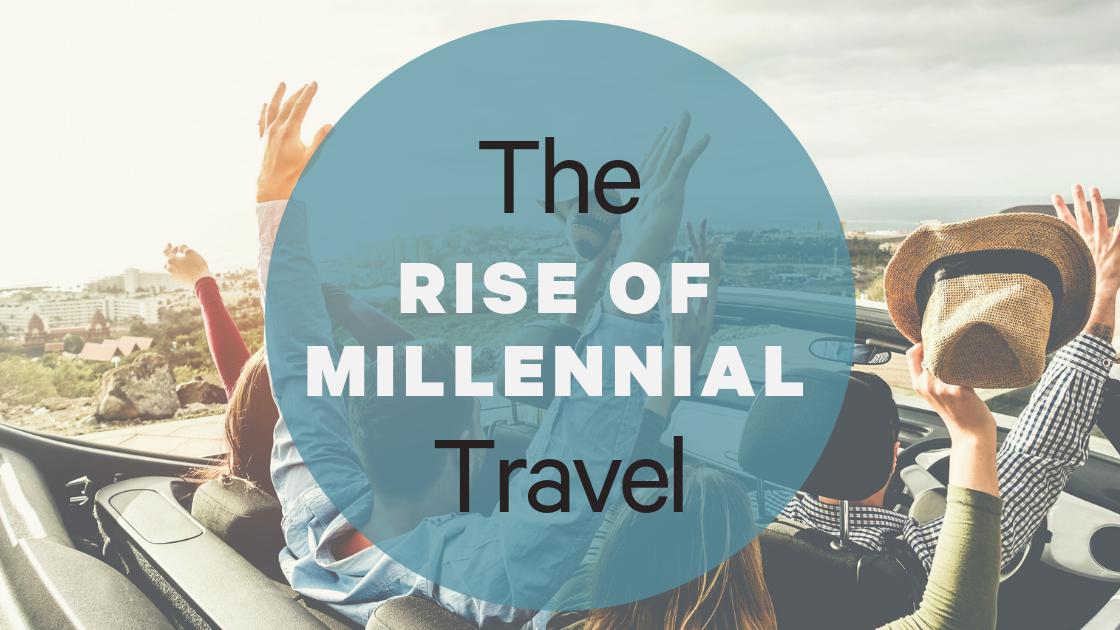Written by: Elizabeth McHeffey
While meeting with Millennials in different destinations across the U.S., just about all have placed a true prioritization on their passion for travel. With booking apps at our fingertips and social media influencers parading dreamy images of mosaiced mosques and fields of wildflowers, it’s no wonder that my peers and I have been coined the ‘wanderlust generation’. It is a part of our identity, our growth and self-discovery, and is much more than an annual all-inclusive, never-leave-the-resort vacation. Taking a spontaneous weekend ski trip is not out of the ordinary, and neither is a backpacking trek through the Himalayas.
We are traveling more than past generations – case in point, I’m currently exploring the country as a digital nomad.
We are also spending the most on travel compared to all other generations – $200 billion annually per Forbes. Moreover, our generation is blurring the lines of business and leisure travel, extending the short business trip that our other-generation colleagues are eager to hop on a same-day return flight from. Conference in Boise? I think I will stay an extra two nights to search for the natural hot springs in the region.
Why so? The digital age has been a great motivator. With the ability to book a flight on your smartphone in seconds, WiFi accessibility in even the most remote places (always connected!), and the influx of wanderlust social media influencers – it makes it hard to not get bit by the travel bug.
“Travel is so easily done, it’s in your face, travel is at our fingertips as a Millennial. I think that’s why we are more inclined to take a vacation, to take a month off and go backpack through Europe. The previous generations didn’t have the ‘in your face’, ‘this is available to you’ marketing. They probably didn’t know ‘oh, I could go skydiving this weekend’ or ‘I could go hiking through the forest’ or ‘I can visit the Amazon’. For us, we think, ‘that could be my vacation in two months!’” says Nani Almanza, Visitor Services Manager with Visit Monterey.
Additionally, Millennials are earning 20% less than Baby Boomers did at the same stage of life, according to this USA Today article. Coupled with much higher student debt and other contributing factors, many Millennials have adopted “live in the moment” or “bucket list” mentalities.
Randi Morritt, Director of Marketing with Visit Aurora and I talked about some of the travel patterns of our generation. “Many individuals in our generation [Millennials] feel financially burdened by significant student debt, and there’s data that supports the cost of higher education is greater now than ever before which is a shift from previous generations. With new headlines about Millennials ‘killing’ a new industry every day, I think we get a bad rep for holding off purchasing a first home or a new car. Instead of hurrying towards those larger financial goals, a travel goal can be achieved on a smaller scale that is more financially attainable.” She continues, “Millennials are choosing to travel and take part in unique experiences. We are a culture that collects moments rather than things.” Buy a house or experience the rich history of Savannah? Millennials have been choosing the latter.
For employers, it is important to realize that this generation and (more likely than not) future generations highly prioritize travel. Discussed in the previous blog post, Millennials look for flexibility and paid time off in an employer and may be more likely to negotiate PTO or remote workdays over salary increases. When meeting with the senior leaders of Visit Denver, we talked about their organization and how they have evolved and are continuously open to new ways of thinking, influenced by all their generations in the workforce.
Rachel Benedick, VP of Sales and Services says, “It is important, understanding over the years, the priorities of the younger generations. [Millennials prioritize] flexibility and time off….and they will take time off over money any day of the week.” Richard Scharf, President & CEO, emphasizes, “Especially in Colorado!” Rachel continues, “Our people take all of their vacation, they take every bit of it. And they go and they do things.” They have team members going to faraway places like Japan, Israel and Vietnam and have noticed that their Millennials are taking all their paid days off. Joking that it is a big contrast to them, who have more vacation time than they know what to do with.
And Millennials don’t just want to see a destination, they want to be immersed in it. We are travelers, not tourists, and desire to taste authentic cuisine and stay in historic neighborhoods, rather than Times Square-esque locations or cram onto a tour bus as outsiders gazing in. We want to collect memories to share with our peers, connect with locals and learn from our experiential explorations. Whether it be an Anthony Bourdain-inspired foodie trip, socially conscious opportunity to give back, or a spiritual retreat in Sedona, we want originality and authenticity. We want a curated, unique experience, a storyline, a central concept. The more that a destination can do so, the more likely we are going to be on a plane, train, car, bike or hovercraft to get there.
“We are kind of looking for more out of the norm out of our lives. We are traveling more, we are seeing more of the world, we are experiencing more.” shares Kylie Leslie, Destination Experience Designer with Visit Phoenix.
Elizabeth McHeffey is our digital nomad. During her travels she’ll be diving into topics and trends surrounding the generations in the workforce, stopping along the way to meet with industry leaders that are making waves and reinventing how we work. What we’re calling, “The Remote Route.”
[mkdf_button size=”” type=”” text=”Read more about The Remote Route Here” custom_class=”” icon_pack=”font_awesome” fa_icon=”” link=”https://searchwideglobal.com/blog-why-searchwide-global-has-one-millennial-employee-embarking-on-a-digital-nomad-lifestyle/” target=”_self” color=”” hover_color=”” background_color=”” hover_background_color=”” border_color=”” hover_border_color=”” font_size=”” font_weight=”” margin=””]
SearchWide Global is a full-service executive search firm primarily for companies in Destination Organizations / Hotels & Resorts / Venue Management / Experiential Marketing, Tradeshow & Exhibition / Industry Associations / Sports & Entertainment. Specializing in C-Level and Director level executive searches for companies ranging in size from Fortune 500 corporations to mid-sized public and private companies and associations. Founded in 1999, SearchWide Global headquartered in St. Paul, MN, USA and operates worldwide.

